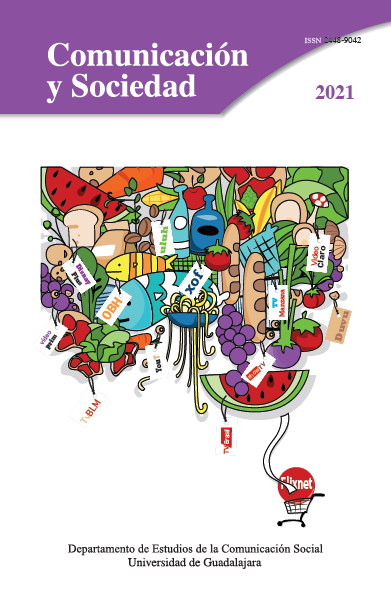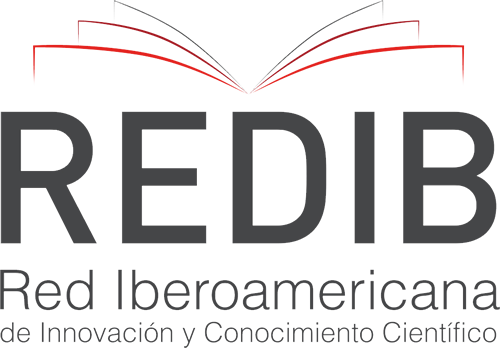Representaciones familiares en los canales de niños menores creadores de contenidos en YouTube. Un análisis comparado de España, Estados Unidos y Reino Unido
DOI:
https://doi.org/10.32870/cys.v2021.87750Palabras clave:
Niños menores, Creadores de contenidos, Youtubers, Familia, GéneroResumen
El objetivo de este estudio es analizar el tipo de familia que aparece representada en los canales de YouTube protagonizados por niños menores de 14 años de España, Estados Unidos y Reino Unido. Se ha seleccionado aleatoriamente un total de 450 videos de 15 canales entre los años 2016-2018 y se aplica un análisis de contenido. Los resultados muestran que la representación mediática de los miembros de la familia sigue manteniendo la estructura de familia tradicional, diferencias culturales en cuanto a cómo la familia participa en los videos según el país y la presencia del padre o la madre como coprotagonista.Descargas
Citas
Abidin, C. (2017). #familygoals: Family Influencers, Calibrated Amateurism, and Justifying Young Digital Labor. Social Media + Society, 3(2), 2056305117707191. https://doi.org/10.1177/2056305117707191
Aparici, R. & García-Marín, D. (2018). Prosumidores y emirecs: Análisis de dos teorías enfrentadas. Comunicar: Revista Científica de Comunicación y Educación, 26(55), 71-79. https://doi.org/10.3916/C55-2018-07
Araújo, C. S., Magno, G., Meira, W., Almeida, V., Hartung, P. & Doneda, D. (2017). Characterizing Videos, Audience and Advertising in Youtube Channels for Kids. Social Informatics, 10539, 341-359. https://doi.org/10.1007/978-3-319-67217-5_21
Auxier, B., Anderson, M., Perrin, A. & Turner, E. (2020, 28 de julio). Parenting Children in the Age of Screens. Pew Research Center. https://www.pewresearch.org/internet/2020/07/28/parenting-children-in-the-age-of-screens/
Baxter, S. M., Kulczynski, A. & Ilicic, J. (2016). Ads aimed at dads: Exploring consumers’ reactions towards advertising that conforms and challenges traditional gender role ideologies. International Journal of Advertising, 35(6), 970-982. https://doi.org/10.1080/02650487.2015.1077605
Beaujot, R. & Liu, J. (2005). Models of Time Use in Paid and Unpaid Work. Journal of Family Issues, 26(7), 924-946. https://doi.org/10.1177/0192513X04273583
Berg, M. (2018, 3 de diciembre). How This 7-Year-Old Made $22 Million Playing With Toys. Forbes. https://www.forbes.com/sites/maddieberg/2018/12/03/how-this-seven-year-old-made-22-million-playing-with-toys-2/
Bergen, M. (2019, 20 de marzo). Kidfluencers’ Rampant YouTube Marketing Creates Minefield for Google. Bloomberg. https://www.bloomberg.com/news/articles/2019-03-20/kidfluencers-rampant-youtube-marketing-creates-minefield-for-google
Bernárdez Rodal, A. (2018). Soft Power: Heroínas y muñecas en la cultura mediática. Editorial Fundamentos.
Bianchi, S. M. (2000). Maternal employment and time with children: Dramatic change or surprising continuity? Demography, 37(4), 401-414. https://doi.org/10.1353/dem.2000.0001
Bourdieu, P. (1996). On the Family as a Realized Category. Theory, Culture & Society, 13(3), 19-26. https://doi.org/10.1177/026327696013003002
Boyle, K. & Berridge, S. (2014). I Love You, Man. Feminist Media Studies, 14(3), 353-368. https://doi.org/10.1080/14680777.2012.740494
Bronfenbrenner, U. (1977). Toward an experimental ecology of human development. American Psychologist, 32(7), 513-531. https://doi.org/10.1037/0003-066X.32.7.513
Bruns, A. (2014). Beyond the producer/consumer divide: Key principles of produsage and opportunities of innovation. En D. Araya, M. A. Peters & T. Besley (Eds.), The new development paradigm: Education, Knowledge economy and digital futures [Series Global Studies in Education, Volume 20] (pp. 51-65). Peter Lang Publishing Inc. http://www.peterlang.com/index.cfm?event=cmp.ccc.seitenstruktur.detailseiten&seitentyp=produkt&pk=79369&cid=450
Campaign for a Commercial-Free Childhood-CCFC. (2016). Federal Trade Commission Must Stop “Influencer” Marketing Targeting Kids on YouTube and Other Digital Sites. Center for Digital Democracy. https://www.democraticmedia.org/filing/federal-trade-commission-must-stop-influencer-marketing-targeting-kids-youtube-and-other
Carrera, P., Blanco-Ruiz, M. & Sainz-de-Baranda Andújar, C. (2020). Consumo mediático entre adolescentes. Nuevos medios y viejos relatos en el entorno transmedia. Historia y Comunicación Social, 25(2), 563-574. https://doi.org/10.5209/hics.72285
Chau, C. (2010). YouTube as a participatory culture. New Directions for Youth Development, 2010(128), 65-74. https://doi.org/10.1002/yd.376
Coltrane, S. (2000). Research on Household Labor: Modeling and Measuring the Social Embeddedness of Routine Family Work. Journal of Marriage and Family, 62(4), 1208-1233. https://www.jstor.org/stable/1566732
Coltrane, S. & Adams, M. (1997). Children and gender. En T. Arendell (Ed.), Contemporary parenting: Callenges and issues (pp. 219-253). SAGE.
Committee of Advertising, Advertising Standards Authority. (2017). Recognition of advertising: Online marketing to children under 12. https://doi.org/10.1111/j.1741-3737.2000.01208.x
Craig, D. & Cunningham, S. (2017). Toy unboxing: Living in a(n unregulated) material world. Media International Australia, 163(1), 77-86. https://doi.org/10.1177/1329878X17693700
Craig Watkins, S. (2009). The young & the digital. What the Migration to Social-Networks Sites, Games, and Anytime, Anywhere Media Means for Our Future. Bacon Press.
DeAngelis, M. (2014). Reading the bromance: Homosocial relationships in film and television. Wayne State University Press.
Draper, N. A. (2014). Defining Family: Representation and Rhetoric in the Marketing of Shared Mobile Phone Plans. Critical Studies in Media Communication, 31(1), 57-71. https://doi.org/10.1080/15295036.2013.831991
Elizalde-San Miguel, B., Díaz Gandasegui, V. & Díaz Gorfinkiel, M. (2019). Is Involved Fatherhood Possible? Structural Elements Influencing the Exercise of Paternity in Spain and Norway. Journal of Family Issues, 40(10), 1364-1395. https://doi.org/10.1177/0192513X19839753
Eurostat. (2015). Harmonised European Time Use Surveys (HETUS)— Overview. Eurostat. https://ec.europa.eu/eurostat/web/time-use-surveys
Evans, Y. N. (2020). One-sided Social Media Relationships and the Impact of Advertising on Children. Pediatrics, 146(5). https://doi.org/10.1542/peds.2020-017533
Folkvord, F., Bevelander, K. E., Rozendaal, E. & Hermans, R. (2019). Children’s bonding with popular YouTube vloggers and their attitudes toward brand and product endorsements in vlogs: An explorative study. Young Consumers, 20(2), 77-90. https://doi.org/10.1108/YC-12-2018-0896
Geena Davis Institute on Gender in Media. (2015). Cinema and Society: Shaping our Worldview Beyond the Lens Investigation on the Impact of Gender Representation in United Kingdom Films. Geena Davis Institute on Gender in Media.
Gill, R. (2007). Gender and the Media. Polity Press.
Herrero-Diz, P., Ramos-Serrano, M. & Nó, J. (2016). Los menores como usuarios creadores en la era digital: Del prosumer al creador colaborativo. Revisión teórica 1972-2016. Revista Latina de Comunicación Social, 71, 1.301-1.322. https://doi.org/10.4185/RLCS-2016-1147
Hofstede, G. (2004). Cultures and Organizations. Software of the Mind (Vol. 2).
Hofstede, G., Hofstede, G. J. & Minkov, M. (1984). Culture’s Consequences: International Differences in Work-Related Values. SAGE. McGraw-Hill.
Hofstede, G. (2020). The 6 dimensions model of national culture. https://geerthofstede.com/culture-geert-hofstede-gert-jan-hofstede/6d-model-of-national-culture/
Hook, J. L. & Wolfe, C. M. (2013). Parental Involvement and Work Schedules: Time with Children in the United States, Germany, Norway and the United Kingdom. European Sociological Review, 29(3), 411-425. https://doi.org/10.1093/esr/jcr081
Hoover, S. M., Clark, L. S. & Alters, D. F. (2003). Media, Home and Family. Routledge.
IAB Spain. (2018a). Estudio Anual del eCommerce en España. IAB Spain.
IAB Spain. (2018b). Guía legal sobre niños influencers. IAB Spain.
IAB Spain. (2019). Libro Blanco sobre Marketing de influencers. IAB Spain.
Instituto Nacional de Estadística-INE. (2010). Encuesta sobre el Uso del Tiempo / Time Use Survey (TUS). https://www.ine.es/en/prensa/eet_prensa_en.htm
Jenkins, H., Ford, S. & Green, J. (2015). Cultura Transmedia: La creación de contenido y valor en una cultura en red. Gedisa.
Jordan, A. B., Hersey, J. C., McDivitt, J. A. & Heitzler, C. D. (2006). Reducing children’s television-viewing time: A qualitative study of parents and their children. Pediatrics, 118(5), e1303-1310. https://doi.org/10.1542/peds.2006-0732
Kotler, P. (2010). The Prosumer Movement. En B. Blättel-Mink & K.-U. Hellmann (Eds.), Prosumer Revisited: Zur Aktualität einer Debatte (pp. 51-60). VS Verlag für Sozialwissenschaften. https://doi.org/10.1007/978-3-531-91998-0_2
Lacalle, C. & Hidalgo-Marí, T. (2016). La evolución de la familia en la ficción televisiva española. Revista Latina de Comunicación Social, 71, 470-483. https://doi.org/10.4185/RLCS-2016-1105
Lange, P. G. (2014). Kids on YouTube: Technical Identities and Digital Literacies. Routledge.
Lee, C. K. C. & Beatty, S. E. (2002). Family structure and influence in family decision making. Journal of Consumer Marketing, 19(1), 24-41. https://doi.org/10.1108/07363760210414934
Lighici, C. (2015). Comparación institucional entre España y el Reino Unido: Marco institucional, evolución durante la crisis económica y la importancia estratégica de las instituciones = Institutional comparison between Spain and the United Kingdom : institutional framework, evolution during the economic crisis and the strategic importance of the institutions (Tesis de grado). Universidad de León, España. https://buleria.unileon.es/handle/10612/4560
Livingstone, S. (2002). Young People and New Media: Childhood and the Changing Media Environment. SAGE.
Livingstone, S. (2008). Taking risky opportunities in youthful content creation: Teenagers’ use of social networking sites for intimacy, privacy and self-expression. New Media & Society, 10(3), 393-411. https://doi.org/10.1177/1461444808089415
Livingstone, S. & Blum-Ross, A. (2019). Parents’ Role in Supporting, Brokering or Impeding Their Children’s Connected Learning and Media Literacy. Cultural Science Journal, 11, 68-77. https://doi.org/10.5334/csci.124
Livingstone, S., Ólafsson, K., Helsper, E. J., Lupiáñez‐Villanueva, F., Veltri, G. A. & Folkvord, F. (2017). Maximizing Opportunities and Minimizing Risks for Children Online: The Role of Digital Skills in Emerging Strategies of Parental Mediation. Journal of Communication, 67(1), 82-105. https://doi.org/10.1111/jcom.12277
López de Ayala, M. C., Haddon, L., Catalina-García, B. & Martínez-Pastor, E. (2020). The dilemmas of parental mediation: Continuities from parenting in general. Observatorio (OBS*), 14(4), 119-134. https://doi.org/10.15847/obsOBS14420201636
López Villafranca, P. & Olmedo Salar, S. (2019). Menores en YouTube, ¿ocio o negocio? Análisis de casos en España y EUA. El Profesional de la Información, 28(5), 15. https://doi.org/10.3145/epi.2019.sep.20
Lucal, B. (1999). What it means to be gendered me: Life on the boundaries of a dichotomous gender system. Gender & Society, 13(6), 781-797. https://doi.org/10.1177/089124399013006006
Lui, L. & Choi, S. Y. P. (2015). Not Just Mom and Dad: The Role of Children in Exacerbating Gender Inequalities in Childcare. Journal of Family Issues, 36(13), 1829-1853. https://doi.org/10.1177/0192513X13510300
Maestre, L. L. (2014). Los niños como EMIRECs de producciones audiovisuales, una práctica educomunicativa (Tesis doctoral). Universidad Nacional de Educación a Distancia, España. https://dialnet.unirioja.es/servlet/tesis?codigo=44073
Marsh, J. (2016). ‘Unboxing’ videos: Co-construction of the child as cyberflâneur. Discourse: Studies in the Cultural Politics of Education, 37(3), 369-380. https://doi.org/10.1080/01596306.2015.1041457
Martínez-Pastor, E. (2019). Menores youtubers en el ecosistema publicitario de los juguetes: Límites normativos. Revista Espacios, 40(7), 5-15. http://www.revistaespacios.com/a19v40n07/19400705.html
Martínez Pastor, E. & Nicolás Ojeda, M. Á. (2019). Panorámica de las reclamaciones en publicidad y menores en Autocontrol (1998-2018). Comunicación y Hombre, 15, 163-176. https://doi.org/10.32466/eufv-cyh.2019.15.362.163-176
Martínez Pastor, E., Nicolás Ojeda, M. A. & García Manso, A. (2016). A theoretical review of the child socialisation process in spain. Prisma Social: Revista de Investigación Social, Extra 1, 378-399. https://revistaprismasocial.es/article/view/1325
Martínez-Pastor, E., Ongkrutraksa, W. & Vizcaíno-Laorga, R. (2020). Una aproximación a los niños Youtubers tailandeses. El caso de los menores como prescriptores de juguetes. Revista Mediterránea de Comunicación, 11(1), 213-223. https://doi.org/10.14198/MEDCOM2020.11.2.1
Martínez Pastor, E., Serrano Maíllo, M. I., Gavilán, R. & Nicolás Ojeda, M. A. (2017). Los niños ante la publicidad. OMM Press. https://dialnet.unirioja.es/servlet/libro?codigo=758355
McRoberts, S., Bonsignore, E., Peyton, T. & Yarosh, S. (2016). Do It for the Viewers! Audience Engagement Behaviors of Young YouTubers. Proceedings of the The 15th International Conference on Interaction Design and Children, 334-343. https://doi.org/10.1145/2930674.2930676
Medina Bravo, P., Figueras-Maz, M. & Gómez-Puertas, L. (2014). El ideal de madre en el siglo XXI. La representación de la maternidad en las revistas de familia. Estudios sobre el Mensaje Periodístico, 20(1), 487-504. https://doi.org/10.5209/rev_ESMP.2014.v20.n1.45244
Moschis, G. P. & Churchill, G. A. (1978). Consumer Socialization: A Theoretical and Empirical Analysis. Journal of Marketing Research, 15(4), 599-609. https://doi.org/10.1177/002224377801500409
Neuendorf, K. A. (2020). The Content Analysis Guidebook (Second edition). SAGE. https://us.sagepub.com/en-us/nam/the-content-analysis-guidebook/book234078
Nieto Moreno, A. & Sosa Troya, M. (2019, 24 de febrero). El polémico negocio de los niños ‘youtubers’. El País. https://elpais.com/sociedad/2019/02/23/actualidad/1550955595_762719.html
Ofcom. (2019). Children and parents: Media use and attitudes report 2018. Ofcom. https://www.ofcom.org.uk/research-and-data
Padilla‐Walker, L. M., Coyne, S. M. & Fraser, A. M. (2012). Getting a High-Speed Family Connection: Associations Between Family Media Use and Family Connection. Family Relations, 61(3), 426-440. https://doi.org/10.1111/j.1741-3729.2012.00710.x
Ramos-Serrano, M. & Herrero-Diz, P. (2016). Unboxing and brands: Youtubers phenomenon through the case study of evantubehd. Revista Prisma Social, 90-120. https://revistaprismasocial.es/article/view/1315
Renobell Santaren, V. (2020). Comparando la estructura social entre España y Reino Unido en momentos de cambios. 3C Empresa. Investigación y pensamiento crítico, 9(2), 41-71. http://ojs.3ciencias.com/index.php/3c-empresa/article/view/1019
Rideout, V. & Robb, M. B. (2020). The Common Sense census: Media use by kids age zero to eight. Common Sense Media. https://www.commonsensemedia.org/sites/default/files/uploads/research/2020_zero_to_eight_census_final_web.pdf
Rocha-Sánchez, T. E. & Díaz-Loving, R. (2005). Cultura de género: La brecha ideológica entre hombres y mujeres. [Culture and gender: An ideological gap between males and females.]. Anales de Psicología, 21(1), 42-49. https://revistas.um.es/analesps/article/view/27111
Rodrigo Martín, L. R. & Rodrigo Martín, I. (2016). Advertising, Children, Family and Education. Revista Prisma Social, 338-377. https://revistaprismasocial.es/article/view/1324
Roömer-Pieretti, M., Vizcaíno-Laorga, R. & Melendo Rodríguez-Carmona, L. (2020). Formación para los riesgos de las TIC en el ámbito escolar. Educación, escuelas y TIC: Tres caras de una misma moneda. En B. Catalina-García, A. García-Jiménez, & M. Roömer-Pieretti (Eds.), Creciendo en un mundo virtual. Cómo actuar ante la realidad digital (pp. 115-124). OMMPRESS Educación.
Schroeder, J. E. & Zwick, D. (2004). Mirrors of Masculinity: Representation and Identity in Advertising Images. Consumption Markets & Culture, 7(1), 21-52. https://doi.org/10.1080/1025386042000212383
Siwa, J. (2019, 20 de marzo). Kidfluencers’ rampant YouTube marketing is a minefield for Google. Adage. https://adage.com/article/digital/kidfluencers-youtube-marketing-a-minefield-google/317058
Skalski, P. A., Neuendorf, K. A. & Cajigas, J. A. (2020). Content Analysis in the Interactive Media Age. En The Content Analysis Guidebook (pp. 201-242). SAGE. https://us.sagepub.com/en-us/nam/the-content-analysis-guidebook/book234078
Smahel, D., Machackova, H., Mascheroni, G., Dedkova, L., Staksrud, E., Ólafsson, K., Livingstone, S. & Hasebrink, U. (2020). EU Kids Online 2020: Survey results from 19 countries. EU Kids Online. https://doi.org/10.21953/lse.47fdeqj01ofo
Social Blade. (2020). YouTube, Twitch, Twitter, & Instagram Statistics. https://socialblade.com/
Takeuchi, L. (2011). Families Matter: Designing Media for a Digital Age. The Joan Ganz Cooney Center at Sesame Workshop. https://joanganzcooneycenter.org/publication/families-matter-designing-media-for-a-digital-age/
Tsai, W. S. (2010). Family man in advertising? A content analysis of male domesticity and fatherhood in Taiwanese commercials. Asian Journal of Communication, 20(4), 423-439. https://doi.org/10.1080/01292986.2010.496860
Tur-Viñes, V., Núñez Gómez, P. & González-Río, M.-J. (2018). Menores influyentes en YouTube. Un espacio para la responsabilidad. Revista Latina de Comunicación Social, 73, 1211-1230. https://doi.org/10.4185/RLCS-2018-1303en
Tur-Viñes, V., Núñez-Gómez, P. & Martínez-Pastor, E. (2019). YouTube, menores y cultura colaborativa. Revisión bibliográfica de la investigación académica. Historia y Comunicación Social, 24(1), 331-351. https://doi.org/10.5209/hics.64498
U.S. Bureau of Labor Statistics. (2018). American Time Use Survey Home Page. https://www.bls.gov/tus/
van Dijk, J. (2006). The Network Society: Social Aspects of New Media. SAGE.
Vizcaíno-Laorga, R., Martínez-Pastor, E. & Serrano Maíllo, I. (2019). Just Within the Limits of the Law: Minors from Consumers of Advertising to Creators of Advertising in Spain. KOME. An International Journal of Pure Communication Inquiry, 7(1), 1-23. https://doi.org/10.17646/kome.75698.99
Walczer, J. (2019). Unboxing Creators’ Algorithmic Trust in Kids’ YouTube. Journal of Design and Science. https://jods.mitpress.mit.edu/pub/fcmpfgk5/release/1
Walker, S. & Barton, L. (2013). Gender, Class and Education (Routledge Revivals). Routledge.
Walter, N. (2010). Muñecas vivientes. El regreso del sexismo. Turner Libros.
West, C. & Zimmerman, D. H. (1987). Doing Gender. Gender and Society, 1(2), 125-151. https://www.jstor.org/stable/189945
West, C. & Zimmerman, D. H. (2009). Accounting for Doing Gender. Gender & Society, 23(1), 112-122. https://doi.org/10.1177/0891243208326529
Westenberg, W. M. (2016). The influence of YouTubers on teenagers: A descriptive research about the role YouTubers play in the life of their teenage viewers (Tesis de maestría). University of Twente, Países Bajos. http://essay.utwente.nl/71094/
World Economic Forum. (2019). Informe Global de Brecha de Género 2020. Foro Económico Mundial. https://es.weforum.org/press/2019/12/gggr20-33b4437b58/
Wu, K. (2016). YouTube marketing: Legality of sponsorship and endorsements in advertising. Journal of Law, Business & Ethics, 59, 59-91.
Yarosh, S., Bonsignore, E., McRoberts, S. & Peyton, T. (2016). YouthTube: Youth Video Authorship on YouTube and Vine. Proceedings of the 19th ACM Conference on Computer-Supported Cooperative Work & Social Computing (1423-1437). https://doi.org/10.1145/2818048.2819961
YouTube. (2020). Estadísticas de YouTube. https://www.youtube.com/intl/es/about/press/
Zafra, R. (2011). Un cuarto propio conectado: Feminismo y creación desde la esfera público-privada online. Asparkia: Investigació feminista, 22, 115-130. http://www.e-revistes.uji.es/index.php/asparkia/article/view/602
Descargas
Publicado
Cómo citar
Número
Sección
Licencia
Derechos de autor 2021 Esther Martínez Pastor, Marian Blanco-Ruiz, Ricardo Vizcaíno Pérez

Esta obra está bajo una licencia internacional Creative Commons Atribución-NoComercial 4.0.
Los autores/as que publiquen en esta revista aceptan las siguientes condiciones:
De acuerdo con la legislación de derechos de autor, los autores conservan los derechos de autoría y otorgan a Comunicación y Sociedad el derecho de primera comunicación pública de la obra. Comunicación y Sociedad no realiza cargos a los autores por enviar y procesar artículos para su publicación.
Los autores/as pueden realizar otros acuerdos contractuales independientes y adicionales para la distribución no exclusiva de la versión del artículo publicado en Comunicación y Sociedad (por ejemplo incluirlo en un repositorio institucional o publicarlo en un libro) siempre que indiquen claramente que el trabajo se publicó por primera vez en Comunicación y Sociedad.











